 B7
B7
Chapter 5
THREE BASIC BLUES IN E
When I was just starting out, Dave Van Ronk taught me a version of the traditional "John Henry" similar to this one.
It is almost completely played off of the "normal" E chord (plus two brief forays into B7, with a 6th string bass).
Your right index and middle fingers will have a few tricky moves to learn--but the piece still sounds GREAT.
Let's first practice the E bass line, for most of this piece is on the E chord. The right thumb alternates between the sixth and fourth bass notes...Back and forth, like a Choo Choo train.
Remember--from the chapter on Tablature--what Right hand finger usually plays what string? (Of course you don't.) Well, use Right Index on the Third string, right Middle (or maybe ring) on the First string.
Your Left Pinky will get a work-out here: Those c# notes are played on the 2nd string, second fret.
Measure 7: Note the "d" on the 2nd string third
fret, next to the c#:
 B7
B7
When the E chord returns, there's a cute little twist.
Look at Measure 12
The rest is easier. Use your left pinky for the First string's
"g"notes in
Ready? Switch to the new B7 in the middle of Measure 19
The last full measure is just our old Fingerpicking Pattern #1 again (from Chapter 4).
Now that you're used to a steady alternate bass....forget it!
DON'T alternate your bass on this classic blues by Mance Lipscomb--he
didn't, and nobody ever complained. In fact, try muting the 6th string to sound
like his thunk-thunk "monotonic" bass on the 6th string, for full
78-RPM old-time effect:
Rest your right wrist slightly on the bass string, just enough to
dull the sound without stopping it completely. When it sounds like a
1920s washtub bass, you've got it.
The piece starts with your Left Ring playing the 1st string, Third fret.
It'll do this a lot.
Try the slide in Measure 4, second beat. It's on the 3rd string, second
to fourth frets:
Measure 7
If I wanted to confuse you I'd call the chord on the second beat a B7+9
---so I won't.
The piece ends with a BASS RUN, so stop playing the repeated bass you've
finally gotten used to, and play the notes in Measure 8:
This is a great little groove to keep playing over and over, once you
memorize the piece.
Ooooh, you're thinking, you have to memorize them too?
Hey, the more you play 'em, the easier they get--'till you sit down one
night and you can play the first part of a piece by heart, without looking at the
music! That's the time to play a few measures more, close the book and try to
play them from memory. Open to the page only when you get stumped. Little by
little the piece will anchor itself into your brain (just like that stupid poem
you had to memorize once for speech class).
Think of this tune as a group of little modules that repeat each time
they're called up.
The A7 measure is one module, the E7 another. You play the SAME thing
in each measure of E7 (or A7), until the "turn around" at the end.
First, the A7 module.
So play these notes in this order:
The rhythm is tricky--so read the following help on
off-beats:
This is the "AND" of the count.
Are you now ready (hah!) for the E7 module?
I'm separating the syllables for "ham-mer" to emphasize its TWO
equally
strong notes. Sound the first note using a right hand finger--but the Second
one is sounded with the LEFT hand alone.
Why am I doing this to you? Now, now, the blues is syncopated. This
means the good stuff keeps cropping up on the weak beats--in the unexpected
places, like the police.
The ham-mer is a corner stone of guitar music from classical (called
"legatos") to Heavy Metal (Trill or be Trilled). You'll get 'em.
The "Turn Around":
The last two measures are termed "Turn Around" because they are used
to set up the piece to start over again from the beginning:
Use the normal E7, A7 and Ami here (to make sure you're not just
mindlessly popping those modules in over and over). See the chord chart Normal Chords if you're in doubt.
The piece ends with a single measure of the E7 module. Follow these modules
carefully, and you'll be playing the right notes--or "close enough for
blues."
More info/contact Andy:
http://www.andypolon.com
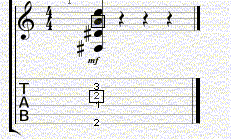 The B7 has a funny bass line. Put your left middle on the Sixth string for that funky f# note. Play it with your right thumb, of course. The next bass note is the fourth string d#. Very C & W.
The B7 has a funny bass line. Put your left middle on the Sixth string for that funky f# note. Play it with your right thumb, of course. The next bass note is the fourth string d#. Very C & W.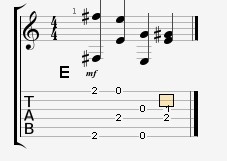 Play an OPEN 3rd string on the third beat, simultaneously with the bass
(E, open 6th string). Then immediately play g# on the 3rd string (left index)
simultaneously with another bass note (this time on the 4TH string). Is
this why they call it the blues?
Play an OPEN 3rd string on the third beat, simultaneously with the bass
(E, open 6th string). Then immediately play g# on the 3rd string (left index)
simultaneously with another bass note (this time on the 4TH string). Is
this why they call it the blues?
Measure 14:
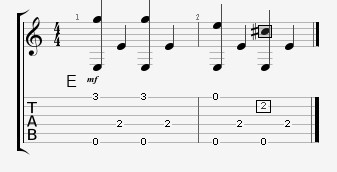
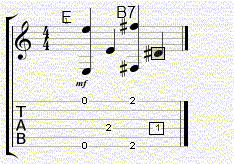
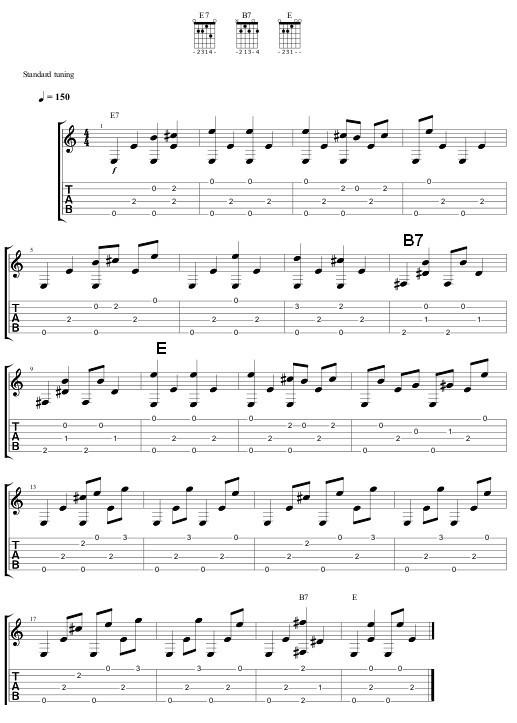
BABY PLEASE DON'T GO
Hear The Music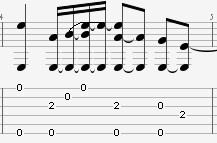 Second beat: Play the second fret note (an "a") ALONG WITH the
bass--but slide up on the 4th fret ("b") Real Fast. You have to play
the 1st string's open "E" BEFORE the next bass note anyway, so rush the
slide Emphasize the end of it (rather than the first part).
Second beat: Play the second fret note (an "a") ALONG WITH the
bass--but slide up on the 4th fret ("b") Real Fast. You have to play
the 1st string's open "E" BEFORE the next bass note anyway, so rush the
slide Emphasize the end of it (rather than the first part).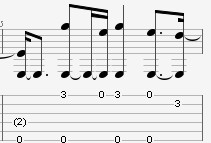 uses a normal B7 chord, but your Left little Pinky'll have to
stretch a bit to play the second string 3rd fret ("d"). Then take the
left pinky off to play the second string open:
uses a normal B7 chord, but your Left little Pinky'll have to
stretch a bit to play the second string 3rd fret ("d"). Then take the
left pinky off to play the second string open: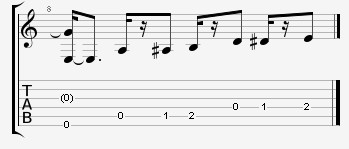 Stress the First of each pair of eighth notes in this "bass run."
Eventually they'll make sense. So will this "8 bar blues," if you
practice it slowly enough.
Stress the First of each pair of eighth notes in this "bass run."
Eventually they'll make sense. So will this "8 bar blues," if you
practice it slowly enough. BABY PLEASE DON'T
GO
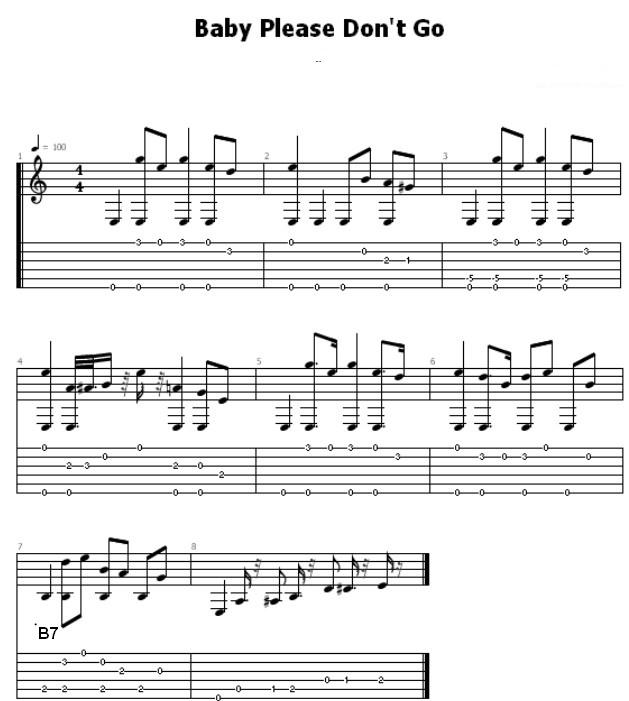
ROCK ME BABY

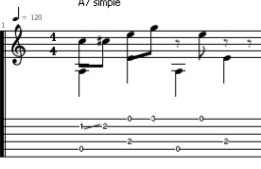
Use your Left Middle and Ring for the chord--but SLIDE these two up from
the first to the second fret. And don't do this until AFTER the first bass
note.
Repeat this module over and over until it either starts to make sense (or you
simply MUST use the john).A Word On The "Off-Beat":
Count a Four Beat Measure this way:
+--+ +--+ +--+ +--+
¦-+--+--+--+--+--+--+--+
¦------------------------¦
¦1-AND-2-AND-3-AND-4--AND¦
¦------------------------¦
¦------------------------¦
The numbers here are the Bass Notes--the "On-beats"
The "ANDS" are the eighth notes between the bass notes.
They're called
the "off-beats," because they're on the weak, (unnatural) beat.
Practice counting "one-AND-two-AND-three-AND-four" aloud on your way
to work and I guarantee you'll make progress (and gain solitude!).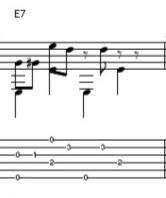
(E7)
+--+ +--+ +--+ +---+ +--+ +--+
+-++h+--0--+-+--0--------+-+h+-0--+--+--0--------+
+-++_+--+--3-+---------+-+-+_+-+--3--+-----------¦
+-+0_1--+----+---------+-+-0-1-+-----+-----------¦
+-+-----2----+-----2---+-+-----2-----+------2----¦
+-+----------+---------+-+-----------+-----------¦
+-0----------0-----------0-----------0-----------+
The ham-mer gives you two notes for the work of one. In this piece it's
isolated--between bass notes.
Later on we'll co-ordinate ham-mers
and basses in the strangest places, with the most fascinating mutations.
The B7 crops up in Measure 9: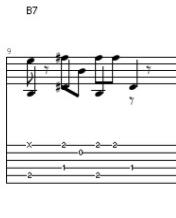
(B7)+-+ +-+ (A7) +--sl +-+ +-+
+---2-+--2-2----------------+-+_+-0-3-+-0--------+
+---+-0--+------------+-----+-1_2-+---+----------¦
+---+----+------------+-----+-----+---+----------¦
+---1----+------1-----+-----+-----2---+-----2----¦
+-2------2------------+-----0---------0----------¦
+------------------------------------------------+
It's simple. The A7 measure is a repeat of the "A7 module measure."
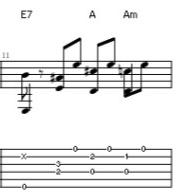
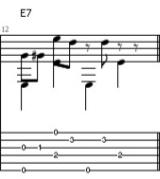
(E7)+-+ A+-+Am+-+ (E7)---+ +-+ +--+
+---+-0--+-0--+-0------+-+h+--0-+--+--0----------+
+---3----2----1------+-+-+_+--+-3--+-------------¦
+---+----+----+------+-+-0_1--+----+-------------¦
+---2----+----+------+-+------2----+------2------¦
+--------0----0------+-+-----------+-------------¦
+0---------------------0-----------0-------------+
Measure 11:ROCK ME BABY
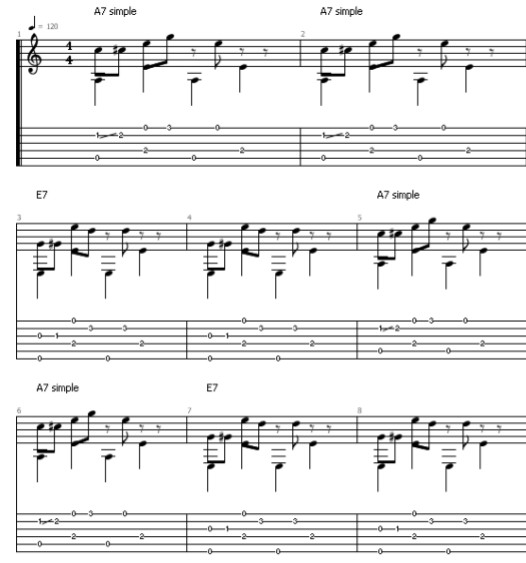
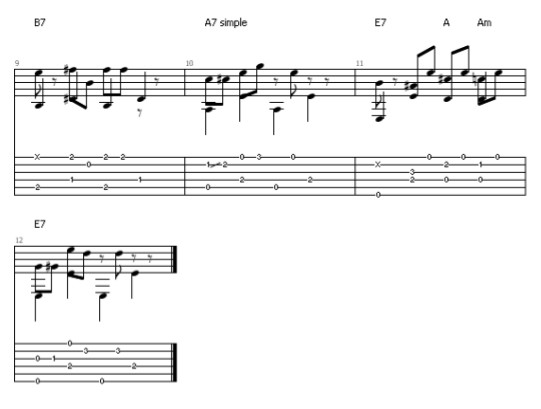
This chapter © 2015 by Andrew D. Polon. All rights reserved.
Back to the
Table Of Contents
Trouble reading the Tab?: Tablature Help Here